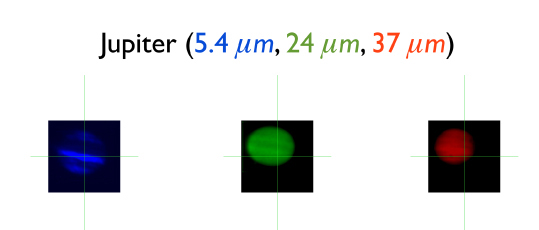
Jupiter data: FORCAST images were taken in three broadband filters with effective wavelengths of 5.4 µm, 24 µm, and 37 µm. The observing mode made use of the chopping secondary mirror operating with a two-position chop at 10 Hz plus nodding the telescope in an ABBA pattern. Data post-processing included: (1) removal of bad pixels and array pattern (correlated) noise, (2) applying a flat-field correction to remove the effects of pixel-to-pixel responsivity variation, (3) subtracting chop and nod image pairs to remove instrument, telescope and sky background signal, and (4) shifting and summing (coadding) multiple integrations to produce the final images. Each monochromatic image was then processed with a spatial filter to remove effects of telescope jitter and the telescope+camera point spread function. Finally, the three monochromatic images were combined into a red-green-blue color image.